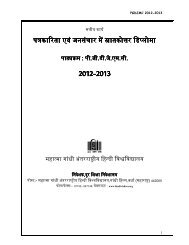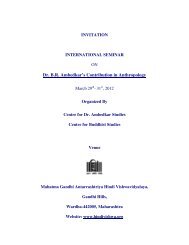Mamta Kalia
Mamta Kalia
Mamta Kalia
Create successful ePaper yourself
Turn your PDF publications into a flip-book with our unique Google optimized e-Paper software.
c) Nihilism- to Baudrillard, the<br />
masses would become so numbed<br />
by media bombardment that they<br />
can no longer be indoctrinated.<br />
Similary, Habermas distinguishes<br />
between three different conservative<br />
positions:<br />
a) The ‘ pre-modernism’ of the ‘old<br />
conservatives’- e.g. F.R. Leavis.<br />
b) ‘anti-modernism’ of the ‘young<br />
conservatives’ (Foucault,<br />
Derrida).<br />
c) ‘post-modernism’ of ‘neoconservatives’<br />
(Daniel Bell).<br />
The neo-conservatives accept the<br />
finality of the separation of the spheres<br />
of science, morality and art from each<br />
other and also from the ‘life-world’ (to<br />
use Habermas’, terms). Thus their<br />
functional rationality is at the cost of<br />
morality in the social organisation<br />
(politics)- and this position cannot be<br />
acceptable theoretically and practically.<br />
In the long post-modern debate,<br />
Habermas and Jameson took part for<br />
traditional left, Baudrillard for radical<br />
left, and Lyotard and Rorty for<br />
domesticated post- modernism.<br />
Habermas defended the still unrealised<br />
potential of the enlightenment but finds<br />
monolithic rationality as the cause of<br />
the ills of modernity, hence pleads for<br />
the communicative reason (‘Theory of<br />
Communicative Action’, 1981). To<br />
Habermas, there is a problem of three<br />
‘cultural value spaces’ that Max Weber<br />
distinguished- the theoretical (science),<br />
74 :: April-June 2010<br />
the practical (morality) and the aesthetic<br />
(art); and due to specific innerlogic of<br />
each, these cannot be reconciled. These<br />
have different forms of augmentationempirical-<br />
theoretical discourse, moral<br />
discourse and aesthetic discourse-<br />
Habermas calls these as ‘rational<br />
complexes’ which have become exclusive<br />
coteries of experts, hence instead of<br />
enriching daily life (as enlightenment<br />
expected) these have distanced<br />
themselves from ‘the life world’. Further,<br />
under ‘capitalist modernisation’ the<br />
empirical-theoretical or congnitiveinstrumental<br />
rationality complex (meansend<br />
rationalism) has dominated and<br />
marginalised other modes of knowing.<br />
Therefore, in Habermas’ view, it cannot<br />
be modernity. Further Habermas gives<br />
language a central place. Habermas moves<br />
from modernistic, subjectivistic<br />
‘philosophy of consciousness’ to a<br />
‘philosophy of inter-subjectivity’- i.e. of<br />
‘ communication and consensus’. This<br />
inter-subjectivity is all – inclusive and<br />
brings ‘ultimate consensus’, enabled by<br />
communicative reason- thus antirepresentation<br />
would be emancipatory.<br />
Criticising Habermas, however Lyotard<br />
observes that since consensus is only<br />
‘a particular state of discussion, not its<br />
end’, political emancipation may be<br />
realised through dissensus, not<br />
consensus. Actually, to him, consensus<br />
is the end of freedom and thought while<br />
dissensus allows us to have freedom and<br />
to think- that is, to extend our<br />
possibilities. Thus, unlike Habermas, for<br />
Lyotard emancipation depends on the

















